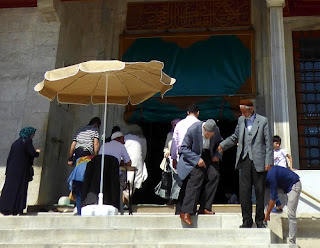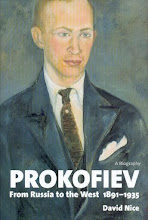Part of my rather fraught decision to return to the Istanbul Music Festival this year, despite the worsening situation under Erdoğan, was the enticement of another chance to discover buildings of all sorts in unexpected corners of this most cosmopolitan of cities (the other part was a wish to support my beleaguered friends and colleagues who still look westwards for some of their enlightenment). I'm well aware, incidentally, that these 'routes' contrast frivolously with the brave long protest march that so many Turkish people are currently undertaking in searing heat*.
Anyway, last year's trail took us either side of İstiklal Caddesi (where the trams and their tracks have currently disappeared; apparently they're due for re-emergence eventually). The starting-point this time was a part of Istanbul I'd not reached, the one-time fishing village of Yeniköy some way up the Bosphorus. I've given some context and necessarily rather telegraphic accounts of the five concerts we heard in the five different venues, three of them top-notch, in my overall coverage of the IMF on The Arts Desk. It remains to give a more pictorial tour.
Our starting point was the Sait Halim Paşa Mansion (pictured up top; I later learned that the seemingly unnatural turquoise colour of the Bosphorus was due to a surge of phytoplankton). I'm not sure that I can add much more to the precis I distilled for The Arts Desk from what historian Mert Taner told us in a cool reception room therein. That's him in the centre above with one of the many vivacious people from the Music Festival, Aysegul Oneren, on the left and fellow writer Jonathan Sutherland on the right. Mert is a true Istanbul mix - Jewish and Muslim parents - and ideally qualified to talk about the different ethnic groups that have existed, and continue in most instances to co-exist, in Yeniköy. It started as the Greek Neapolis and then became a hunting ground for the Byzantine emperors; gazelle pastrami was once on the menu here, but fish (inevitably) much more so; in the village's heyday, there were more than 2000 fishermen here . Lands here were given tax-free to Armenians and Pontic Greeks, who stayed safe in Yeniköy when their brethren were slaughtered in the horrific massacres of the 1950s.
The mansion has had a fascinating history. Its current frame dates from the late 19th century when it was constructed for the father of its most famous occupant, Cairo-born Sait Halim Paşa, whose uncle the Khedive of Egypt commissioned Verdi’s Aida and who eventually rose to the rank of Ottoman Grand Vizier. On 2 August 1914, the crucial German-Ottoman alliance treaty was signed in his study here. One of the few surviving objects from that time is this vast Hunting Scene by the Pasha's chief artistic adviser, French Orientalist Felix-Auguste Clément, who featured himself in the exotic group.
Sait Halim Paşa's playground was otherwise plundered of most of its treasures following his death, when it passed into state ownership, becoming at one point a casino and then the favoured summer residence of Prime Minister Tansu Çiller. Various fires having successively ravaged but not destroyed the building, it was Ciller who initiated a second restoration in 1990, which took some years and was done with fastidious, no-expense-spared attention to craftsmanship and detail. These Iznik tiles in the porch, for instance, were done in the famous town of that name to the highest standards, with horse piss mixed with the ground lapis lazuli to make the right shade of blue.
One visitor threw up her hands in horror at what she presumed to be contemporary bad taste, but that would have been the Pasha's east-west confabulation. I loved this high-level kitsch, of course, especially the staircase
and the views through into light-filled rooms with windows on the Bosphorus.
We were to return here for our second half-hour concert of the route, but the first meant walking to and from the Armenian church of Saint Mary to hear soprano Ayşe Şenogul and harpist Merve Kocabeyeler. Simple, this, but appealing, with some nice naive plaster work and a pleasing light blue.
Then it was back along the main drag parallel to the Bosphorus, with tantalising glimpses of balconies and more turquoise,
to the mansion, past the lions and scrolls of its west front facing the busy main street parallel with the Bosphorus
along the pathway
and up the staircase
to the ballroom on the first floor to hear Italian strings (as I've written in the Arts Desk piece, not a patch on the Istanbul Chamber Orchestra we heard the same time last year).
More views across open shutters to the other side of the Bosphorus.
Next stop, since we were denied the refreshments provided for some business group sporting little blue badges - I grabbed a simit from over the road - were the two Greek Orthodox churches in close proximity down streets with more of the old wooden houses which I was to see in profusion in the poorer Fener district the next day (snapped and described in this blog entry).
It was a feather in the cap of the Festival that it could wangle permission to perform in these sacred buildings; it doesn't usually happen, but the Patriarch happens to be a keen patron of the arts. Most opulently appointed was Aya Yorgi.
It provided a superb acoustic for a major talent among young quartets, the Semplice - must do what I can do get them concerts here - who showed total sophistication and beautiful phrase endings along with And Karabacak in Mozart's Clarinet Quintet (there's a much better professional shot of the players in action over on TAD, but this gives you a second overall idea).
As you can see, Aya Yorgi has a very fine iconostasis,
and though I'm assuming - information being in short supply - that few if any objects here, not even the splendid icons,
were of great antiquity, the colours glowed.
Loveliest setting of all the churches was that of the Panayia, with its detached wooden tower above the church proper on the slopes of Yeniköy. The church was inaugurated in 1848; the tower may be older.
I found that I'd strolled into the garden of a house in the grounds, but the owner made me very welcome and her dog dozed in the shade, too fazed by the afternoon heat to get excited about all the attention.
The interior of the church was gloomier, more mysterious than the others. I sat beside some rather splendid dragon bench-ends for the choir stalls
wondering about the cockerel climbing atop the rood screen
and afterwards snapped the young, Istanbul-raised Azeri violinist unquestionably destined for great things, Elvin Hoxha Ganiyev, with the Festival's totally charming Director, Yeşim Gürer Oymak.
A short walk took us to the Austrian Cultural Forum, the Palais Yeniköy built as one of those summer residences for the embassies so fashionable in the second half of the 19th century. Though it now has the busy road running under its east-facing windows, the views are still essential
and chandeliers of Murano glass add to the opulence whether you're looking in this direction
or, most spectacularly, facing the main ballroom area where our Vienna-based trio gave their very accomplished recital.
In fact I've never seen such a whopper - Venetian glass always strikes me as super-kitsch, but here the extravagance verges on the sublime and fits the end-of-Empire decadence.
Franz Josef I's monogram gives the game away above the mirrors and elsewhere:
and the Grand Staircase is a glory of late-19th century ironwork.
It was pleasing, all the same, to see the EU and Austrian flags halfway up. They're concealed here, but the point was to catch two of the Trio Immerso as they left.
Final outdoor shots in the late afternoon sun: on the steps of the ACF - Jonathan, Assistant Director Efruz Çakirkaya, my sometime helper Günsu Yeşilyaprak (couldn't have been nicer or more efficient) and Aysegul.
Strollers presumably looking forward to the cannon-shot that announces the end of the day's Ramadan fasting
Those of us not observant of such customs were desperate for something more than the day's bread roll (OK, I forget breakfast). And so, strolling back down the road past mini-harbours,
we adjourned to an excellent cafe specialising in that very specific kind of Turkish ravioli called manti. Here are Yeşim and Efruz again - lovely people, as you can tell. Would that all festivals were run by folk like this! But that's Istanbul for you.
*9/7 And today they arrived in Istanbul, their only demand - justice. There's a great shot within this article of Kemal Kılıçdaroğlu, leader of the Republican People's Party, throwing red and white carnations to the crowd. Aren't people amazing?

















































































